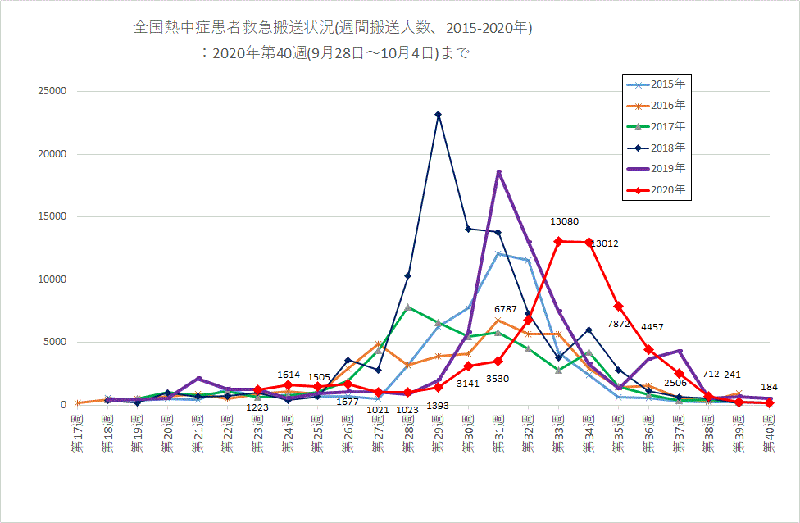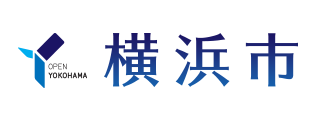- Yokohama-shi Top Page
- Health, Medical and Welfare
- Health and Medical Care
- institute for health
- Health Information
- The topic of health
- Heat stroke information
- Emergency transport of heat stroke patients nationwide (2020)
Here's the text.
Emergency transport of heat stroke patients nationwide (2020)
Last Updated October 24, 2024
Emergency transport of patients with heat stroke nationwide: Until the 40th week of 2020 (September 28-October 4)
Heat stroke often occurs in hot summers, and the Fire and Disaster Management Agency of the Ministry of Internal Affairs and Communications summarizes the emergency transport status of heat stroke patients from May to September in Japan every year. In fiscal 2020, May was not included in the survey period to reduce the burden on fire departments due to the impact of COVID-19, but a short survey period from Monday, June 1. The graph below shows the number of weekly transporters in the emergency transport status of heat stroke patients nationwide since 2015. In fiscal 2020, it is indicated by red lines. Every year, after the rainy season, the number of emergency transporters of heat stroke patients increases rapidly. Looking at the relationship between the end of the rainy season in the Kanto Koshin region and the peak week of the number of emergency transports for heat stroke patients nationwide, the 28th and 31st weeks in 2015, the 30th and 31st weeks in 2016, the 27th and 28th week in 2018, the 26th week and 29th week 29th week 29th week 29th week 29th week 29th week, and 29th week 29th week, and 10th week, and 10th week 10th week, and 10th week 10th week, and 20th week 20th week, and 10th week, and 20th week 20th week As in 2016, 2017, and 2019, the week following the end of the rainy season in the Kanto Koshin region is often the week of the peak of the number of emergency transports for heat stroke patients nationwide.
The rainy season in the Kanto Koshin region is usually around June 8, but the rainy season in the Kanto Koshin region in 2020 is around June 11, and the 24th week immediately after the rainy season (June 8-14) and the 25th week (June 15-21), the maximum number of emergency transports for heat stroke patients nationwide was 15 weeks after each week. The maximum value may be related to the high humidity just after the rainy season, and there are more opportunities to wear masks to combat corona than usual.
The rainy season in the Kanto Koshin region is usually around July 21, but the rainy season in the Kanto Koshin region in 2020 is slower than usual around August 1, and in 2020, the 29th week immediately before the end of the rainy season (July 13-19) to the 31st week (July 27 to August 2 for each case) is from the minimum number of 2. In the 32nd week (August 3-9), the week following the end of the rainy season in the Kanto Koshin region, the number of emergency transports for heat stroke patients nationwide surged to 6,787. From the 33rd week (August 10 to 16) to the 36th week (August 31 to September 6), all weeks were the maximum for each week after 2015. The relationship between the end of the rainy season in the Kanto Koshin region and the peak week of the number of emergency transports for heat stroke patients nationwide was in the 31st and 33rd weeks in 2020. In 2020, the week following the end of the rainy season in the Kanto Koshin region was the peak week of the number of emergency transports for heat stroke patients nationwide.
According to a summary of the Fire and Disaster Management Agency of the Ministry of Internal Affairs and Communications (reference: Fire and Disaster Management Agency of the Ministry of Internal Affairs and Communications, "Emergency Transport Situation Due to Heat Stroke in 2020," October 27, 2020), the ratio of elderly people aged 65 and over to emergency transport personnel due to heat stroke was the highest at 57.9%. Due to the COVID-19 pandemic, many people were in their homes ahead of going out, and many elderly people were at home. From May to September, when there are many heat strokes, heat stroke measures are also important in addition to corona measures.
From June to September in Japan in 2020 (Reiwa 2), the number of emergency transport personnel for heat stroke patients was 64,869 (including 112 deaths), and in the six years from 2015 to 2020, it was 2018 (92710), followed by 2019 (666869). By month, August was the most common with 43,060 people (including 81 deaths), and the most common in August of the six years from 2015-2020. It was the largest in June, with 6,336 people (including 8 deaths) and the largest in June of 2015-2020. In July, the number was as low as 8,388 (including 18 deaths), and the lowest in July of the six-year period from 2015-2020. If the rainy season in 2020 (Ryowa 2) ends in early August, July 2020 (Ryowa 2) does not include a sudden increase immediately after the rainy season. In 2020 (Reiwa 2), the end of the rainy season was slower than usual, and the slower the summer with heat stroke was shorter. As the end of the rainy season in 2021 (Riwa 3) is earlier than 2020 (Riwa 2), the number of emergency transport personnel for heat stroke patients in 2021 (Riwa 3) may increase compared to 2020 (Riwa 2). There is a possibility, and caution is required in 2021 (Riwa 3).

Graph of the number of emergency transport personnel weekly for patients with emergency heat stroke from 2015 to 2020
In addition, the above graph is created using the figures announced by the Fire and Disaster Management Agency of the Ministry of Internal Affairs and Communications website heat stroke information "List of Past Data (From 2008) (outside site)". The number of emergency transport personnel and the number of fatalities for heat stroke patients in the week of 2020 (Reiwa 2) in the graph is the monthly report (confirmed value) from June to September, and the weekly report (preliminary value) in October. We use numerical value of.
In addition, for more information about heat stroke, please see our Yokohama City Inst. of Health web page "Let's prevent heat stroke (heatstroke, sunstroke)" .
Reference webpage
- Fire and Disaster Management Agency of the Ministry of Internal Affairs and CommunicationsHeat stroke information (outside site)」・「List of past data (from 2008) (outside site)」
- Yokohama City Inst. of HealthHeat stroke information」
- Yokohama City Inst. of HealthEmergency transport of patients with heat stroke nationwide (2018)」
- Yokohama City Inst. of HealthEmergency transport of patients with heat stroke nationwide (2019)」
- Yokohama City Inst. of HealthEmergency transport of patients with heat stroke nationwide (2021)」
First published on June 2, 2021
Inquiries to this page
Infectious Diseases and Epidemiology Information Division, Medical Care Bureau Institute of Health
Telephone: 045-370-9237
Telephone: 045-370-9237
Fax: 045-370-8462
Email address: ir-eiken@city.yokohama.lg.jp
Page ID: 572-926-053







